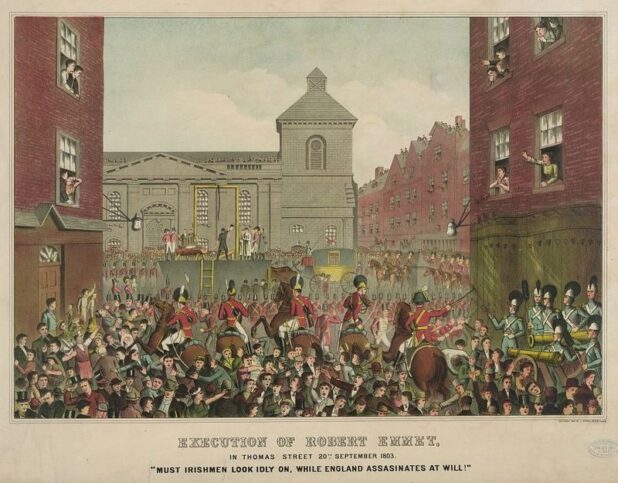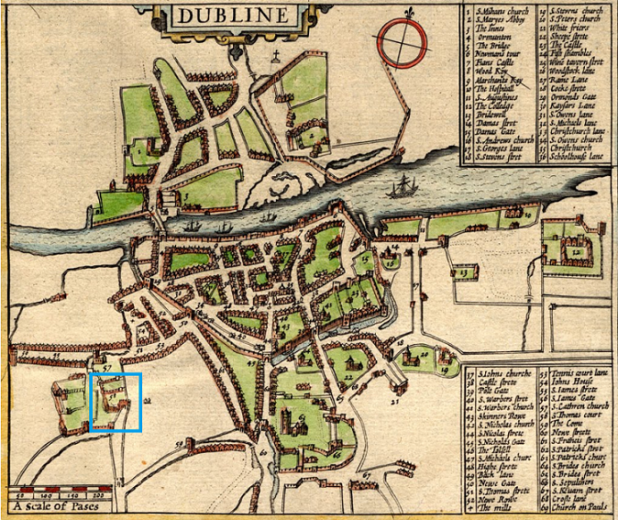St Catherine’s A History – Craig O’ Reilly delves into the history to St Catherine’s, scene of Robert Emmet’s grizzly demise.
St Catherines is a site in the liberties which is steeped in history. At times it was a centre of power in Dublin, while at other points in time it was supressed. In 1803 it was the site of the Irish republican and orator Robert Emmett’s execution, and he is commemorated by a plaque which remains at St Catherine’s there to this day. The story of St Catherine’s Church, the graveyard, and the abbey it belonged to goes far back in history, with various incarnations coming in and out of historical sources. Here we take a look at how this graveyard site stretches back eight hundred years as part of much contested struggles for power in Ireland in the Middle Ages.
The Abbey Of St Thomas The martyr
In the Middle Ages, in English Law, a liberty was an area of land where the rights of the King was given over to private hands. The Liberty Of Thomas Court was the site of a church named after Thomas Becket, Bishop of Canterbury, after he was murdered in his Cathedral on 29 December, 1170, by followers of King Henry II.
The Abbey named after him began as a church founded in this area in 1177 by William FitzAldelm; a man who was not well liked by the Irish people. It is speculated this was on account of him allowing relics known as “the Staff of Jesus,” and “Superaltare marmoreum Sancti Patricii” or “the leper’s alter-relic” to be transferred from Armagh to Dublin, a centre of English influence.
The Abbey Of St Thomas The Martyr was representative of royal power; it had a chamber within known as the King’s chamber; and the King himself was invited to lay the foundation stone. It even took upon itself judicial functions, which have lent itself to the original name “Thomas Court”.
As for what happened to the Abbey, We know that parts of it were destroyed by a fire in 1289, but these were reconstructed at the wishes of the King. Again in 1392 a dormitory and a number of guest rooms were destroyed. The existence of the original buildings seem to have been threatened on many occasions.
The Original St Catherine’s Church
St Catherines at this time, was a chapel of ease used for convenience by those who could not reach the main church. Over time, this would be separated into its own parish, but would remain under the control of St Thomas’s abbey.
As for the remains of those buildings of St Catherine’s church and the original abbey, we know very little about what happened to it. No real trace of it lies above ground anymore, it is a building which appears and disappears out of sources. The graveyard of St Catherine’s however, has been a feature of the Liberties since the earliest days.
John Smyth, the Dublin architect, referenced the graveyard in a statement given in 1634:
“For the burial place or churchyard belonging to the abbey, I do think that the churchyard now of St Katherines Church was their burial place for strangers, and the rest buried within the abbey in several places, whereof there were many vaults and dark places for that use. Katherine’s church is reputed to be a chapel of ease unto the abbey of St Thomas’s Court, as I have heard.”
The King’s chamber was still there in 1488, and St Catherine’s Church can be seen on Speeds map of Dublin in 1610 although the Abbey is now referred to as Thomas Court Bawn. Both remained a feature in the Liberty of St Thomas for some time before they were replaced.
Ultimately the King Himself, Henry IIIV dissolved these monasteries, having a particular dislike of Thomas Becket.
St Catherine’s Church Up Until Today
The current church was built in1760. It was designed by John Smith, whose work can be seen all over Dublin. His designs can be seen in the figures atop the College of Surgeons, St Andrews Church, Westland Row and the GPO. He also assisted his father with the figures on the Bank of Ireland.
It is this church of St Catherine’s which was the site of Robert Emmet’s death, and though it served as a place of worship for Protestant members of the public, its doors were closed in 1966 as the protestant population began to decline in the Liberties.
In subsequent years it was maintained by Dublin Corporation. There were occasional concerts there by artists such as Christy Moore, but it eventually fell into disrepair, and was subject to vandalism.
St Catherine’s graveyard especially was a concern for people at the time. A book containing many of the inscriptions of the gravestones and plaques at Saint Catherine’s was compiled by Sean Murphy in 1987, and he preserved many which are now gone.
He noted at the time:
The graveyard to the rear of St Catherine’s Church was converted into a public park by Dublin Corporation in 1985, and superficially it may appear to be an attractive and tasteful piece of work. Unfortunately, in the course of conversion work about 58 of the 124 surviving tombstones were removed from the graveyard, and others were uprooted and relocated within the yard. The missing stones include a memorial to Robert Bagot and his wife dated 1613016, and one to the memory of eighteen children interred by the protestant orphan society 1840-8”
He also notes that until the 1820s, Catholics were unable to have separate graveyards for their dead, and so it was not unusual to find Catholics among the register of those buried in Church of Ireland graveyards like St Catherine’s.
In 1990, Dublin City Council sold St Catherine’s Church as part of an inner-city development program, and it came under ownership Anglican Group City Outreach For Renewal And Evangalism -CORE, who largely restored the interior and who operate youth services in the area.
You can still go and visit the St Catherine’s graveyard today, and it remains one of the oldest and most historical places to see in the Liberties, that very curious and distinct quarter which is so much a part of the fabric of Dublin’s History.











I have been researching the history of St Catherine’s for over a year and have a news item in the Nov/Dec 2023 issue of History Ireland.